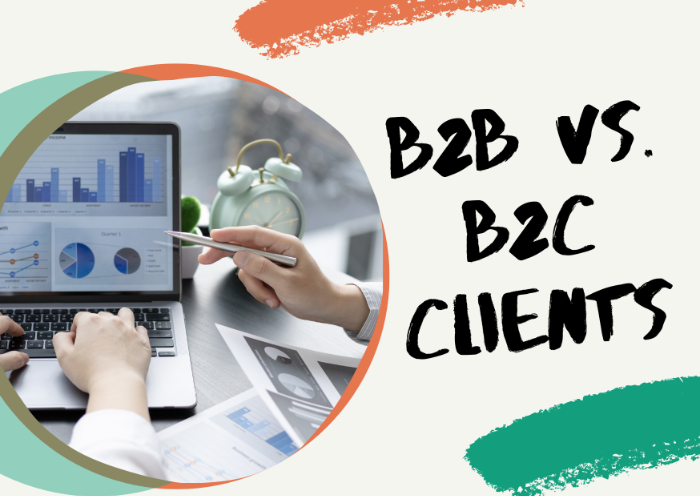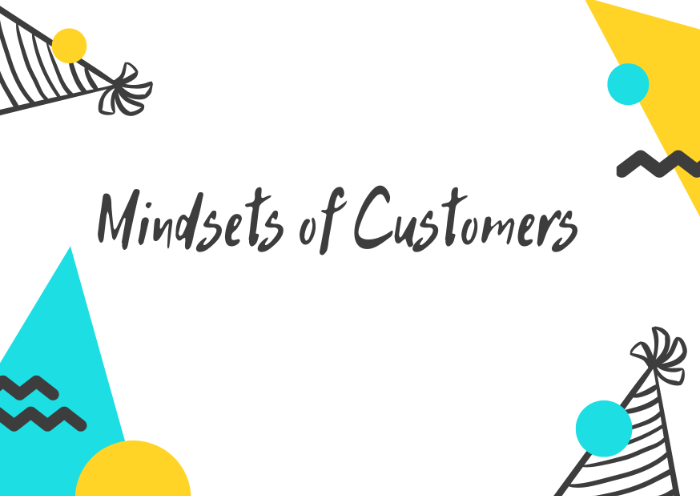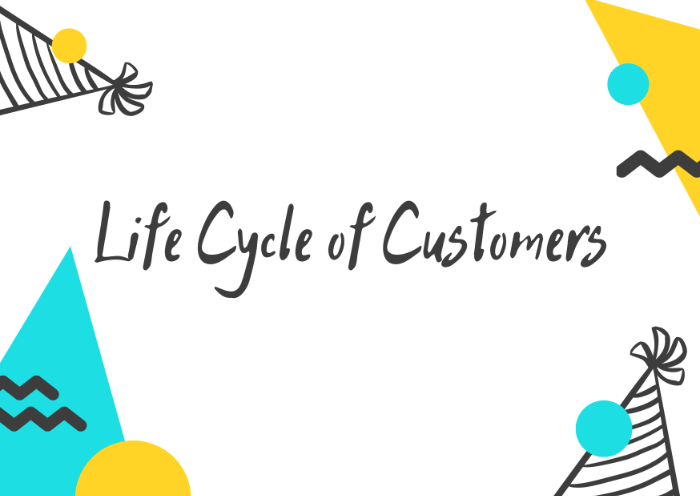B2B and B2C are two business models, and clients differ in both models to great extent. Often single businesses have to follow both models due to their products. Separate sales teams are appointed for B2B and B2C sales. Strategies utilized for both types of marketing and selling are different, the lead generation process and lead requirement also vary. Customers in both cases are different therefore their requirements are different. Business to Consumer model is less complicated, however, the business-to-business model is quite complex. Marketers and sellers have to be very cautious while devising strategies for business-to-business clients.
B2B and B2C both clients have their own importance for businesses. However to improve revenue stream companies must understand the difference between the decision-making of both clients. Factors that influence their decisions and what kind of services are required. B2B clients often require in-depth information, however, the B2C client isn’t much reliant on information. The selling department must know how to deal with B2C and B2B leads, to improve conversion rate. Sales reps can perform as well as the information they possess regarding clients' behavior. Therefore businesses need to learn the difference between business-to-consumer and business-to-business models.

Business-to-Consumer
Business to consumer model sells products or services directly to the consumer in the market. The seller has to interact directly with the customer and provide them information. Many brands around the world work on this model. B2C leads are easily gathered from social media websites like Facebook. Not much information is involved in this model as businesses create an emotional relationship with the customer. The decision-making process is small as there is often a single customer making a decision, the maximum number of people involved in decision-making would be two. The Business-to-consumer approach is easy compared to the other model of selling.
Business-to-Business
Business-to-Business models sell products or services to other businesses in the market. In B2B sales both parties involved are businesses. The clients in this case are businesses, which have more than one decision-maker. The decisions are mostly rational, as companies have to run a business and cannot compromise on the product. Sellers have to do quite a lot of effort in this model compared to the B2C model. A more information-based approach is involved. Business-to-Business model has around 6 to 10 decision makers and sellers must impress all of them to win the customer. B2B clients often stay long and once they like the product or service the sales continue for a long time.
Mindsets of Customers

B2C leads are directly interacting with producers, no middle man is involved in such transaction. Companies sell their products and services directly to the consumer. Sellers use a product-driven approach, where they associate emotions with the product to attract the consumer. Companies market their product by adding emotions to them. Consumer happiness is associated with products and services. Customers require little product information and often ask queries about the price. B2C businesses are established brands and don’t require much marketing as consumers often know about businesses.
A single or two decision makers are involved and by appealing to the emotion of decision makers, selling departments easily sell their products. B2C sales require moderate effort by sellers and the selling process is also much shorter in this model. Business-to-consumer companies use advertisements to appeal to the emotional side of the consumers, sales reps don’t have to be informed about products as clients aren’t interested much in information. The B2C selling process is easy as the client is emotionally approached but requires a huge number of clients. B2C companies have to sell more to earn adequate profit.
B2B leads are much different compared to B2c prospects, as they require much information for conversion. B2B clients are businesses that have more than one decision maker, 6 to 10 decision makers are involved that collectively take decisions of purchasing products or services. The relationship of both parties is rational and little to no emotions are involved in the decision-making process. Sales reps must be well informed to persuade clients and sell products or services. Clients require in-depth knowledge of the company and its product. Prices are compared along with the shipping fees and other relative information.
THE B2B sales model takes up a long time, two to four weeks are required to engage and persuade a client. Clients require all knowledge regarding the product, seller must convey all information available. Offers must be made to persuade the client. All decision-makers must be in agreement to purchase the product. The process takes a long time but efforts have their fruit. B2B leads are rational the don’t involve emotionally with the sellers. Decision makers are also involved in the business field so they know all strategies and tactics of businesses and purchase after properly satisfying themselves.
B2B Market
The business-to-business market is limited as there aren’t many business clients, however, the sales to clients are regular and in bulk. B2B sales models are based on the relationships of both parties. Decision makers create a relationship with the seller that provides products and services. B2B markets are much more competitive due to limited clients, companies compete on basis of product and relationship. Sales departments work to have successful interactions with companies. Expert reps interact with clients and communicate with several decision-makers. Sales reps have to be active and well-informed to satisfy all objections of the client. The sales amount of business-to-business clients is mostly triple that of B2C clients.
B2C Market
The B2C market is vast, companies target individual clients and use an emotional method of approach. The business-to-consumer market is vast however, the seller has to sell products to individual clients. They look for a high quantity of leads to increase sales. B2C leads could be found through social media or referral programs. Business clients don’t require much information and the sales cycle is also short. Small offers and discounts encourage sales. Business-to-consumer sales average around 150 dollars, almost 1/3 of B2B sales. Small scale sales
Decision Making
Business-to-Consumer
B2C sales decisions are often taken by a single person, the person is the only decision maker for purchasing goods or services. Seldom more than one decision-maker is involved. Decision-making in business-to-consumer sales is done by the purchasing party. The decision is emotion-driven; the customer has an emotional touch with the product being purchased. If more than one decision maker is involved the situation could be tough. However, the sales department doesn’t spend much time on Business-to-consumer leads, as they have a high number of people lined up. The sales rep must understand the requirement which speeds up the persuasion process.

Don't know how to increase sales?
No problem, just know people.
Business-to-Business
Business-to-business clients are large-scale purchasers and require an informational approach. Businesses must understand how the decision-making process happens in the B2B model, to optimize the sales process accordingly. B2B leads, start the search for a product based on the problem at hand. Companies identify problems being faced by the workers and look for a solution. Identification of a problem makes a business a sales lead, and clients start looking for a solution to the problem. Consumers would look for solutions and solutions are found on the internet. Blogs and the website of the seller could play an important role in capturing the attention of the prospect. Marketing departments could use social media posts to attract new leads. Existing customers, if both parties have strong relations often refer customers.
Once the customer starts looking for solutions, utilize marketing tools to grab attention, once the client is aware. The evaluation process begins. Customers will evaluate the product based on its quality and price. The Decision-making process is quite complicated for business leads. B2B leads require a lot of data and would evaluate products on different fronts. Several decision makers are involved and a joint decision is made in the end. Buyers seal the deal with sellers and purchase the product. Sales efforts become successful.
Closing the deal doesn’t end the job, business-to-business sellers require repeat customers. THE B2B market isn’t vast and therefore sellers create relationships and strong bonds with customers. The sales department asks for feedback to improve their products. Discount offers are provided to strengthen the ties between both parties. Seller tries to create relationships that would last longer and the product of the company has the most influential role in this case.
Decision-making for B2B clients is much more difficult than for B2C leads, sellers have to utilize different strategies to seal the deal. Product quality and pricing could influence the purchaser’s decision. Customers spend most time searching for a solution, so the first impression of the company should be strong to leave an image. The sales department must provide all the essential information required. Companies have specific requirements; sales reps must personalize the information being provided. Transparent information much important because sellers want to retain customers. So, keep everything clean and clear. Influence consumers by providing offers and sales discounts on products.
Life Cycle of Customers

The lifecycle of B2B and B2C clients differ, B2C leads tens to have shorter lifecycles compared to B2B clients. B2B clients have more than one decision-maker, and the struggle involved in closing a B2B deal is much high. There are different stages consumers have to pass through, to become customers. The first stage is awareness, customers become aware of the existing problem. B2C prospects would look for advertisements, however, business-to-business clients start research. Awareness is the first stage and in the next stage, businesses start searching. Business clients look for reliable solutions, and several departments are involved because they all are suffering from the problem.
Once the search is complete, the customer outreaches. Customers approach sellers, the actual process starts here when sales reps start persuasion strategies. B2C consumers have an emotional aspect, and a single decision-maker is easy to convert. However, B2B sales require much more. Sales reps use informational techniques to show the resilience of the product. Sellers have to satisfy several decision-makers that are involved. Several departments are affected, so sellers must satisfy the objection of all departments. Converting B2B clients costs high but the return on investment is also high. B2B customers purchase few but bulk quantities. Therefore the high spending is covered. The sales department provides quality service to retain customers as they rely on repeat business.
The last stage is purchasing stage, B2C sales are done on small scale. The purchasing done by the business client is on a high scale. The lifecycle of a B2C client is a maximum of 2 days and for a business client, it's between 2 to 4 weeks. The lifecycle of the customers is different but the objective remains the same. Customers purchase to solve problems and businesses sell for profits.
Final Verdict
The business-to-business sales model is somewhat more complex than the business-to-consumer model. THE B2B model requires an informational approach, however, on the other hand, B2C sales require a large number of leads. The problems, requirements, purchasing scales, selling strategies, and lifecycles all differ in both business models but the objective is the same. One party purchase to solve a problem and the other party sell for profits.



































































